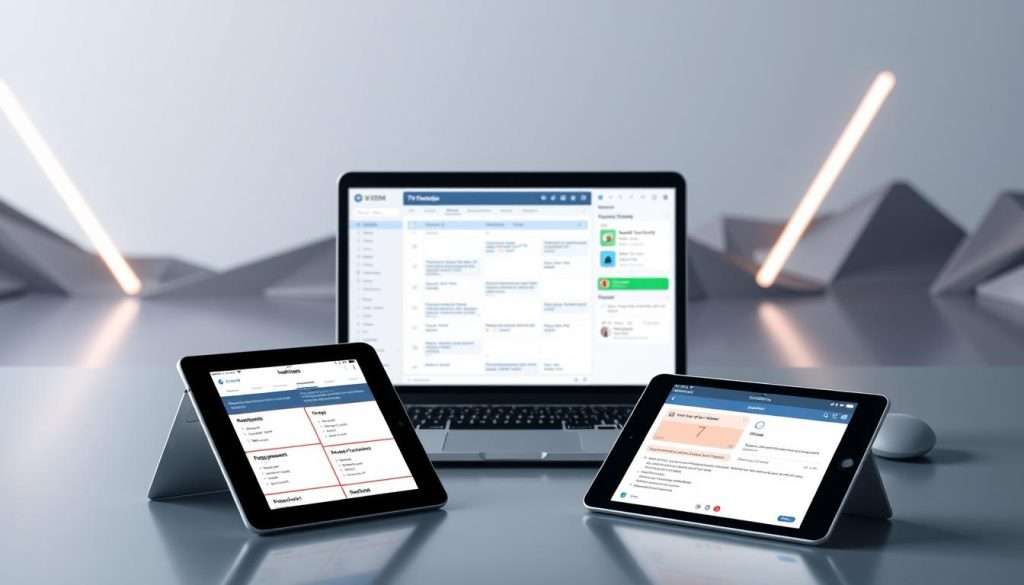Are you tired of cramming for exams and forgetting what you’ve studied soon after? We have a solution for you! Spaced repetition is a powerful technique that can help you retain information better and recall it when needed.
By reviewing material at strategically timed intervals, you can optimize your study sessions and achieve better results. This effective study method is backed by science and can be a game-changer for learners.
So, how does it work? By using a memory improvement strategy that involves reviewing information at gradually increasing intervals, you can help solidify it in your long-term memory.
Key Takeaways
- Spaced repetition is a scientifically proven method for improving memory retention.
- This technique involves reviewing information at gradually increasing intervals.
- It helps solidify information in long-term memory, making it easier to recall.
- Spaced repetition can be used to boost learning and make studying more efficient.
- It’s a powerful tool for learners looking to optimize their study sessions.
The Science of Memory and Forgetting
Memory and forgetting are complex. Our brains handle a lot of information, but not all stays. Knowing why and how we forget helps us learn better.
Understanding the Forgetting Curve
The forgetting curve shows how our memory fades over time. It was first found by Hermann Ebbinghaus. At first, a lot of new info is lost quickly, within hours or days.
This curve shows the struggle to keep new knowledge. It’s why we need memory retention techniques.
How Memory Consolidation Works
Memory consolidation moves info from short-term to long-term memory. It’s vital for learning and keeping info. Spaced repetition helps by reviewing material at the right times.
This makes it easier to remember over time. It’s a key part of good learning strategies.
Learning how memory consolidation works helps us keep info longer. Using spaced learning algorithms improves our memory retention.
What is Spaced Repetition and Why It Works
Spaced repetition is a powerful learning technique. It makes sure you remember things better by reviewing them at the right times. This helps solidify information in your long-term memory.
Definition and Core Principles
Spaced repetition is about reviewing material just before you forget it. This strengthens your memory and stops the forgetting curve. It’s based on the psychological spacing effect, which shows spaced learning is more effective.
The main idea is to review material at optimal learning intervals. These are the best times to refresh your memory without wasting time on things you already know.
The Neurological Basis of Spaced Learning
The brain’s natural processes make spaced repetition systems effective. When you first learn something, it goes into your short-term memory. Reviewing it at spaced intervals helps move it to long-term memory, strengthening neural pathways.
This not only improves retention but also makes recall easier. By using spaced repetition, you’re working with your brain’s natural learning, not against it.
Key Benefits of Spaced Repetition Systems
Spaced repetition offers many benefits, like better retention and time management. It makes studying more effective. This memory improvement strategy boosts your study sessions.
Enhanced Long-term Retention
One big plus of spaced repetition is it helps keep information in your memory for a long time. By reviewing at the right times, you make sure you can remember it later. This effective study method keeps your knowledge fresh, not just for a short time.
Study Efficiency and Time Management
Spaced repetition also makes studying more efficient and helps manage your time better. It focuses on what you’re about to forget, saving you time. This cognitive science technique streamlines your study, helping you reach your goals faster.
Reduced Cognitive Load
Also, spaced repetition reduces mental strain by breaking study into smaller parts. It makes learning less overwhelming. This way, you can keep up a steady study routine without feeling too tired.
Getting Started with Spaced Repetition
Now that we’ve looked at the science behind spaced repetition, let’s get practical. Using spaced repetition can really boost your learning. We’re here to help you get started.
Selecting Material Worth Remembering
The first step is to pick what you want to remember. This could be new vocabulary, historical dates, or key concepts. Focus on the most critical information for your learning goals.
Creating Effective Flashcards
Flashcards are key in spaced repetition. Make them simple and concise. Use one side for the question or term and the other for the answer or definition.
| Flashcard Element | Best Practice |
|---|---|
| Question/Term | Keep it concise and clear |
| Answer/Definition | Provide a clear and accurate response |
Setting Up Your Review Schedule
To make spaced repetition work best, set up a good review schedule. Start with a short interval and increase it as you get better. Use a spaced repetition system to manage your schedule.
By following these steps and using a spaced repetition system, you can improve your learning. You’ll retain more of what you learn.
Popular Spaced Repetition Algorithms Explained
To improve your learning, it’s important to know about spaced repetition algorithms. These systems decide when and how you review material. This helps you remember it better.
The Leitner Box System
The Leitner system is a basic yet powerful method. It uses flashcards and boxes to help you remember. You start with all cards in the first box.
If you answer a card correctly, it moves to the next box. If not, it stays or goes back to the start. It’s perfect for beginners and helps you focus on hard material.
SuperMemo and SM-2
SuperMemo is a leading software that introduced the SM-2 algorithm. It’s used in apps like Anki. This algorithm changes the time between reviews based on how well you do.
It uses a formula that considers how hard the material is and how well you remember it. The SM-2 algorithm is a big step forward in spaced repetition. It makes learning more efficient.
Modern Adaptive Algorithms
Today’s algorithms are even more advanced. They use complex formulas and sometimes machine learning. These algorithms adjust the review schedule, difficulty, and type of material based on your performance.
This personalization is crucial for better retention and less study time. By knowing these algorithms, you can pick the best tool for your learning. This makes your study sessions more effective and efficient.
Digital Tools for Implementing Spaced Repetition
To make spaced repetition work best, using the right digital tools is key. These tools help make studying easier and keep you on track with your goals.
Anki: Customizable and Powerful
Anki is a favorite among learners for its flexibility and strong features. It lets you make digital flashcards and use spaced repetition that fits your learning style. With Anki, you can optimize your study sessions and boost your memory.
Quizlet: User-Friendly and Collaborative
Quizlet is known for its easy-to-use design and teamwork features. You can make your own study sets or explore millions made by others. Its adaptability is perfect for group study sessions or solo studying.
Specialized Apps for Different Subjects
There are apps made just for certain subjects, like language or medicine. These apps have subject-specific content and features that meet the needs of those fields.
Feature Comparison Chart
| Feature | Anki | Quizlet |
|---|---|---|
| Customizability | High | Medium |
| Collaboration | Limited | Strong |
| Subject-Specific Content | No | Yes |
Looking at the features of different tools helps you choose the best one for your learning style.

Low-Tech Spaced Repetition Methods
You don’t need a smartphone to use spaced repetition. Low-tech methods work well too. They’re great for those who like hands-on learning or don’t have digital tools.
Paper Flashcard Systems
Paper flashcards are a simple way to learn. Write a question or term on one side and the answer on the other. This makes a strong memory retention technique.
Organize your flashcards by how well you remember them. Move cards to different piles based on your recall. Cards you remember well go further away, while tricky ones stay closer.
The Physical Box Method
The Physical Box Method, or Leitner system, uses paper flashcards too. You need boxes for different review times (like daily or weekly). Start with all cards in the first box.
Move cards to the next box if you remember them. Cards you struggle with stay in or go back. This keeps your reviews at optimal learning intervals, helping you remember better.
Calendar-Based Review Systems
Use a calendar to plan your reviews. Write down what you want to learn on a specific date. Review it when that date comes. If you remember it, schedule it for a later date.
This spaced repetition system keeps you on track without digital tools. It’s a hands-on way to review at the best times for long-term memory.
Adding these low-tech methods to your study routine boosts memory and learning. You don’t need digital tools to do it.
Optimizing Spaced Repetition for Different Learning Goals
Spaced repetition is a powerful tool, but it needs to fit your learning goals. It works well for many areas, like language learning and professional growth.
Language Acquisition Strategies
Learning a new language? Spaced repetition is great for remembering vocabulary. Use flashcards with words and their meanings. Review them at longer intervals to keep them in your memory.
This method is perfect for languages with tricky writing or tones.
Professional and Academic Knowledge
For keeping up with work or school, spaced repetition is key. It helps remember important concepts, formulas, and dates. Use digital flashcards or apps like Anki to make it easier.
This is great for students studying for exams or professionals needing to stay current.
Skill Development Applications
Spaced repetition isn’t just for remembering stuff. It’s also for improving skills. Musicians can practice complex pieces at longer intervals as they get better.
Athletes can practice new skills to boost their performance over time.
| Learning Goal | Spaced Repetition Application | Benefits |
|---|---|---|
| Language Acquisition | Vocabulary flashcards | Improved vocabulary retention |
| Professional/Academic Knowledge | Concept and formula review | Enhanced retention of key concepts |
| Skill Development | Practice scheduling | Increased proficiency over time |
Building Spaced Repetition into Your Daily Routine
Adding spaced repetition to your daily routine can change how you learn. It makes remembering things easier and more fun. By making it a habit, you’ll remember more and faster.
Creating Sustainable Study Habits
Start by setting aside a time each day for spaced repetition. Being consistent is important. Try to stick to it, even on weekends or days off.
Begin with short sessions and grow them as you get used to it. This helps you stay on track and learn better.
Micro-Learning Throughout the Day
Micro-learning fits well into a busy day. Use times like commutes or breaks to review flashcards or practice recalling information. It boosts your memory and uses time you might otherwise waste.

Combining with Other Learning Techniques
Spaced repetition works better with other learning methods, like active recall or interleaving. Try mixing them to see what suits you best. This way, you create a learning system that fits your needs perfectly.
Measuring Success and Adjusting Your Approach
When you start using spaced repetition, it’s key to see how well it works. You should track how well you remember things, adjust the time between reviews, and change your method for different subjects. This way, you can make spaced repetition work better for you and learn more effectively.
Tracking Retention Metrics
To check if spaced repetition is helping, keep an eye on how well you remember things. You can use a simple table to see how you’re doing:
| Date | Items Reviewed | Correct Recall | Retention Rate |
|---|---|---|---|
| 2023-02-01 | 50 | 45 | 90% |
| 2023-02-08 | 50 | 42 | 84% |
| 2023-02-15 | 50 | 48 | 96% |
Fine-tuning Your Intervals
Adjusting the time between reviews is important. If you remember things easily, increase the time. If it’s hard, make it shorter. This helps you remember better and makes studying easier.
Adapting to Different Types of Content
Spaced repetition works differently for different subjects. For example, learning new words might need more frequent checks than learning grammar. Tailoring your method to the subject helps you remember better and reach your goals faster.
By monitoring your progress, adjusting the review times, and changing your approach for different subjects, you can improve your spaced repetition. This cognitive science technique is a great way to enhance your learning and keep information in your memory longer.
Overcoming Common Spaced Repetition Challenges
Spaced repetition is a great tool, but it comes with its own set of challenges. As you use it to improve your memory, you might face obstacles. These can slow down your progress.
Maintaining Motivation and Consistency
Keeping up motivation and consistency is a big challenge. To beat this, set clear goals and watch your progress. Celebrate your small wins to stay motivated.
Use a habit tracker or a special app to keep track of your daily reviews. Seeing your consistency can really motivate you.
“The key to success is to start before you’re ready.” – Marie Forleo
Managing Review Backlogs
Dealing with review backlogs is another common issue. Falling behind can feel overwhelming. To stay on track, stick to your review schedule by setting aside a specific time each day.
| Day | Reviews | New Cards |
|---|---|---|
| Monday | 20 | 5 |
| Tuesday | 25 | 5 |
| Wednesday | 30 | 5 |
Avoiding Common Pitfalls
Watch out for common mistakes like overloading your study sessions or skipping hard material. To avoid these, plan your study time wisely. Include breaks and focus on tough topics.
By knowing these challenges and finding ways to overcome them, you can make the most of spaced repetition. This will help you reach your learning goals.
Conclusion: Transforming Your Learning with Spaced Repetition
By now, you’ve seen how spaced repetition can change your learning. This method uses spaced learning to help you remember better and study smarter. It’s a top strategy for improving memory.
We’ve looked at different ways to use spaced repetition. You can use digital tools like Anki and Quizlet or simple methods with flashcards and calendars. The important thing is to pick a method that fits you and keep using it.
When you make spaced repetition a part of your daily routine, you’ll see big improvements. You’ll remember things better and study less. This method is not just for memorizing; it’s about learning in a smarter, lasting way.
So, start using spaced repetition in your studies today. You’ll be surprised at how much you can learn. With regular practice, you’ll achieve more than you thought possible.

